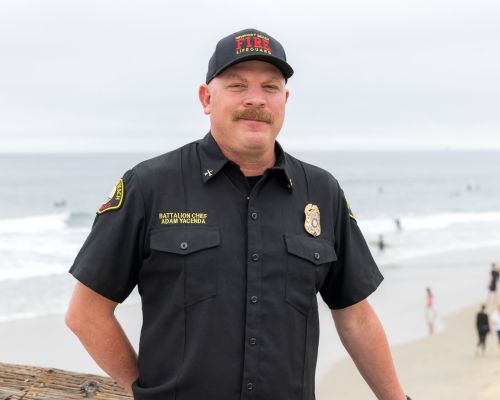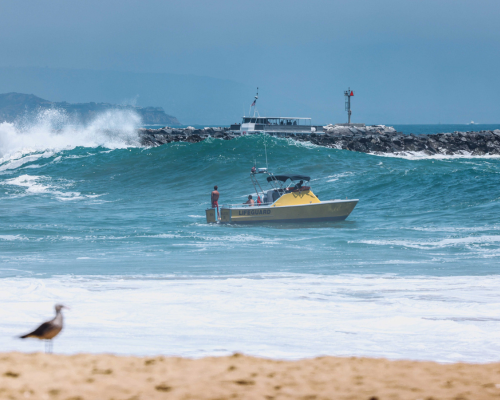City of Newport Beach Lifeguard Department Battalion Chief Adam Yacenda answers important questions about beach safety in time for the summer season.
Parenting OC: What are the top beach safety issues you see as a lifeguard?
Adam Yacenda: The Newport Beach Lifeguard Department is celebrating its 100-year anniversary this year, and for 100 years, the top beach safety issues have been related to the same combination: a lack of awareness of how strong, powerful and potentially dangerous the ocean can be, and the naivety of many beach-goers regarding their own limitations. People come to the beach to have fun. It’s easy for a visitor to get lost in the beauty of the ocean, see those more experienced in the ocean environment having fun, and excitedly hop in unprepared and under-equipped. That’s where we as lifeguards step in. We educate and proactively intervene to prevent dangerous situations from developing in the first place and affect lifesaving measures when they do.
POC: What are the biggest dangers families might encounter at the beach?
AY: Rip currents top this list, and account for over 80 percent of rescues performed by open-water lifeguards. Rip currents are channelized currents of water flowing away from shore and out to sea. An unaware beach-goer can be caught in a rip, and if they can’t swim, may find themselves quickly in water over their head. Even good swimmers caught in rip currents tire rapidly when attempting to fight the current improperly. Rip currents are often found around jetties, piers and rocks, areas which swimmers and waders should avoid for the danger of underwater hazards as well. Rip currents gain size and power when the surf is large. Large surf can hold a swimmer underwater for a long time, or when combined with shallow depths, propel swimmers into the seafloor resulting in the likelihood of traumatic injury. In addition to rip currents, waves and underwater structures, heat and the sun are two big dangers that people don’t think of enough. Heat is the leading weather-related killer in the USA, and heat disorder symptoms can include heat cramps, exhaustion, stroke and sunburn. Families should always remember to stay hydrated and wear sunscreen.
POC: Are sharks ever a concern? What about other sea life?
AY: Sharks are very rarely a concern. All lifeguard agencies along Orange County’s coastline have guidelines and a response plan for shark sightings and human-shark interactions in our waters, but the relative risk of a shark attack here is very small, and fear of an attack should not inhibit anyone from enjoying themselves at the beach. Of vastly greater concern is a relative of the shark, the stingray. Stingrays are flat, bottom-feeding fish with a protective barb at their tail. They come up close to the waterline in shallow water to feed and are stepped on daily by beach-goers at OC beaches. The stingrays use their barb in self-defense, and the resulting wounds really hurt. Fortunately, treatment for the pain is remarkably easy. A hot (not scalding) water bath of the wound will almost immediately reduce the pain, and a continued soak for about 45 minutes to an hour will remove the pain completely. We teach “The Stingray Shuffle.” While wading in the water, walk with a shuffling motion to give stingrays the opportunity to swim away, preventing the likelihood of getting stung.
POC: How should parents prepare and educate their kids about beach safety?
AY: The single most important thing parents can do to prepare their children for safe times at the beach is to get them to learn to swim at the earliest possible age. Not only may the ability to swim save their lives one day, but it also sets them up for a lifetime of more fun and opportunity at the beach. Perhaps it could even lead to the pursuit of athletic endeavors like competitive swimming or water polo. As a parent, the next thing I would consider is enrolling my child in the nearest Junior Lifeguard Program. Junior Lifeguard programs can be found along the entire coastline of Orange County. Most programs are open to 9-year-old children through the early teenage years. Once passing a basic swim test, children spend an entire summer focused on all aspects of beach safety. I firmly believe Junior Lifeguard programs are the premier extracurricular opportunities to be found for children in our region.
POC: What are some tips to keep families safe?
AY:
- Check in with a lifeguard to ask about the day’s safety conditions.
- Swim near a lifeguard.
- Don’t fight the [rip] current. Stay calm and swim sideways or diagonally toward shore to escape its force.
- Cervical injuries are the cause of paralysis and death at the beach each year. Do not dive into shallow water and always protect your head and neck when getting thrown by a wave.
- Understand boogie board, leash and fin safety. Buy your teen a pair of surf fins first, then go get a boogie board. Always have a leash for the board — people sink, boards don’t.
- Sunburns hurt, and skin cancer can kill. Protect yourselves by wearing hats, shirts and sunscreen.
- Alcohol and water don’t mix. Fifty percent of drownings and boating deaths are alcohol-related.
- Children get lost at the beach. Sit near a lifeguard tower, and make sure they know the number or letter on the side of the tower. Write it on the back of the wrist of kids who wander off frequently.
- Broken glass is one of the most dangerous items to young children on the beach. Have them wear shoes or sandals from the car to the campsite and back.
- Fire pits can remain very hot hours to days after they have been used. They are not a play area for children.











Leave a Reply